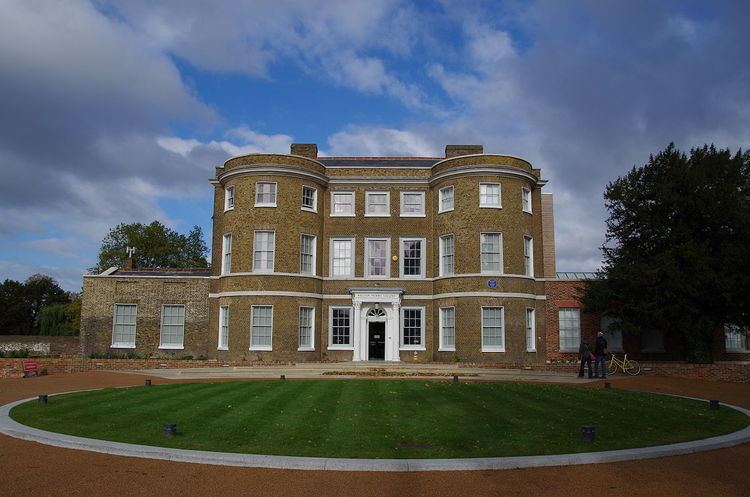Type Museum and exhibitions Public transit access Walthamstow Central Phone +44 20 8496 4390 | Director Waltham Forest Council Website wmgallery.org.uk Founded 1950 | |
 | ||
Established 1950; 67 years ago (1950) Location WalthamstowLondon, E17 Hours Closed today MondayClosedTuesdayClosedWednesday10AM–5PMThursday10AM–5PMFriday10AM–5PMSaturday10AM–5PMSunday10AM–5PMSuggest an edit Similar Lloyd Park, Vestry House Museum, Red House - London, Geffrye Museum, Kelmscott Manor Profiles | ||
William morris gallery walthamstow
The William Morris Gallery, opened by Prime Minister Clement Attlee in 1950, is the only public museum devoted to English Arts and Crafts designer and early socialist William Morris. The gallery is located at Walthamstow in Morris's family home from 1848 to 1856, the former Water House, a substantial Grade II* listed Georgian dwelling of about 1750 which is set in its own extensive grounds (now Lloyd Park). The gallery underwent major redevelopment and reopened in August 2012; in 2013 it won the national prize for Museum of the Year.
Contents
- William morris gallery walthamstow
- William morris gallery museum of the year 2013
- Collections
- Redevelopment
- Lloyd Park
- References
William morris gallery museum of the year 2013
Collections
The gallery's collections illustrate Morris's life, work and influence. They include printed, woven and embroidered fabrics, rugs, carpets, wallpapers, furniture, stained glass and painted tiles designed by Morris himself and by Edward Burne-Jones, Philip Webb, Dante Gabriel Rossetti, Ford Madox Brown, and others who together founded the firm of Morris, Marshall, Faulkner & Company in 1861.
Outstanding exhibits include: Morris's medieval-style helmet and sword, made as 'props' for the Pre-Raphaelite murals at the Oxford Union; the original design for the Trellis wallpaper (the earliest of Morris's many wallpapers); the Woodpecker tapestry woven at Morris's Merton Abbey workshops; the Beauty and the Beast and Labours of the Months tile panels; and The Works of Geoffrey Chaucer printed at Morris's Kelmscot Press. Other exhibits – such as the satchel in which Morris carried his Socialist pamphlets, or the coffee cup he used on his weekly visits to the Burne-Joneses – provide a more personal glimpse of his busy life.
The gallery also holds a substantial collection of furniture, textiles, ceramics and glass by Morris's followers in the Arts and Crafts movement, which flourished from the 1880s to the 1920s. Among those represented are Arthur Heygate Mackmurdo and the Century Guild, William De Morgan, May Morris, Ernest Gimson, Sidney Barnsley, George Jack, C. F. A. Voysey, Harry Powell, Selwyn Image, Henry Holiday, and Christopher Whall.
The collections of applied art are complemented by the Brangwyn Gift, comprising paintings, drawings and prints by Morris's former student Sir Frank Brangwyn as well as works by the Pre-Raphaelites and other Victorian and later artists.
Redevelopment
In 2007, the museum faced a closure threat after its opening hours were cut back as a cost-cutting exercise, breaking a stipulation of gifts by Sir Frank Brangwyn, that works should be on view for a minimum amount of time weekly. Campaigners against the cuts included former Culture Secretary Chris Smith. Subsequently a major redevelopment was carried out.
The William Morris Gallery is owned and managed by Waltham Forest Council. In March 2009 the Heritage Lottery Fund awarded the gallery £80,000 to enable detailed proposals to be developed. In Autumn 2010 this proposal was successful in securing round-two funding of £1.523 million from the Heritage Lottery Fund, which was matched with £1.5 million from the London Borough of Waltham Forest. Further funding was secured from charitable trusts and foundations, notably the Friends of the William Morris Gallery, and through an ongoing public fundraising campaign. Redevelopment of the building and collections finally started in 2011 and after just over a year's closure, reopened on 2 August 2012. For the first month, Grayson Perry's fifteen-metre long Walthamstow Tapestry was on display.
The redevelopment of Water House and was designed by architects and exhibition designers Pringle Richards Sharratt. A new wing, designed to sit comfortably next to the early Georgian architecture of William Morris's house, succeeds in doing so by using similar details – handmade brick with sash windows and gauged brick arches – in a contrasting red brick. The new space houses a new gallery space for temporary exhibitions, toilets and a café with a balcony overlooking the gardens to the rear. The permanent displays and educational areas were completely rearranged, and the project also provides a learning and research centre on the top floor, offices in the basement. New learning programmes and a dedicated website were developed alongside the physical changes.
Lloyd Park
The gardens of the house, now known as Lloyd Park, notably include a moat which pre-dates the Georgian house. As part of the 2012 redevelopment, the disused Waltham Forest Theatre located inside the moat was demolished and made into part of the park. Parts of the park were newly landscaped. A skate park, a new café, gallery space (Winns Gallery), outdoor gym and artist studios in the adjoining Aveling Park were built as part of the same redevelopment project, replacing similar run-down facilities.
The Friends of Lloyd Park exists as a not for profit organisation who work to improve the park and help everyone enjoy it.
